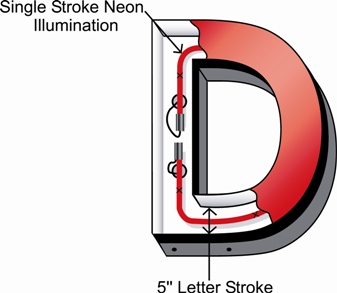May 12, 2012
Why Your Customer Shouldn’t Take the Lowball Quotation

In this nuclear winter economy, you’ve probably heard the words “we received a quotation that was 25% lower than yours.”
Obviously, an unusually low quotation should touch off your customer’s “quality alarm”. But you know that doesn’t always happen.
Whatever the case, as a signage professional, you need to able to point out the common “corner cutting” areas that lowball quotations often involve. For channel letters, illumination is one.
Quick primer: If you are not familiar with the typography term “stroke”, it refers to the thickness of the individual parts of a letter (also called “stroke weight”.) So, a letter part with a “5 inch stroke” means that area of the letter is 5 inches from side to side.
This leads us to the definition of a lighting stroke. A single strand of neon illumination mounted within part of a letter is a single lighting stroke. Two illumination strokes within a letter part is a double stroke, and so on.
And there are limits to how much illumination a single stroke of Neon or LED can effectively produce.

For channel letter signage, here are 3 good illumination “rules of thumb”:
• White LED covers 4 stroke inches (on center)
• Red LED covers 5 stroke inches (on center)
• All Neon covers 5 stroke inches (on center)
So, a common feature of lowball channel letter quotations is to reduce the number of Neon or LED illumination strokes. A sign with insufficient lighting strokes will look OK at best – not excellent, and not professional.
A manufacturer of quality wholesale channel letters (like Direct Sign Wholesale) will not reduce the illumination strokes. We know a poorly illuminated sign will not produce the same brand image or foot traffic as one that is correctly illuminated.
This is just one example of where taking the unusually low quotation can be a “penny wise, pound foolish” decision. Frankly, a poorly illuminated sign makes a business look cheap.
Our next few newsletter issues will key in on some other risk areas of the lowball quotations.
